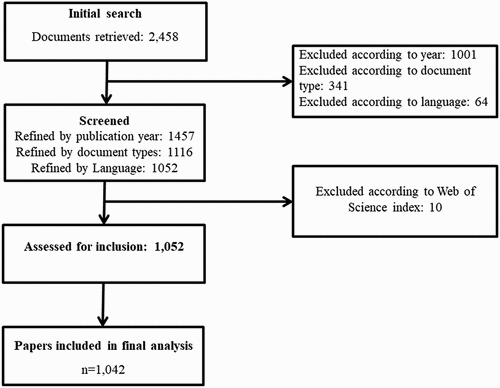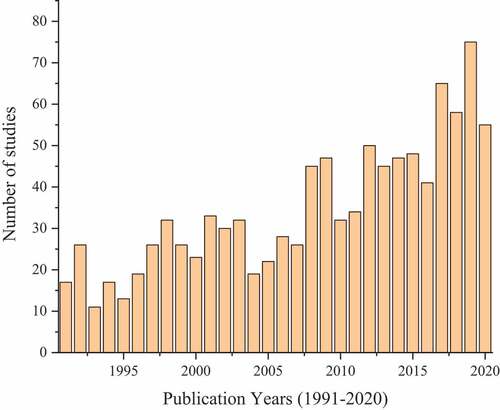ABSTRACT
Introduction
Rabies is an infectious zoonotic viral disease which mainly occurs in Africa and Asia. Dogs are predominantly responsible for rabies transmission contributing up to 99% of all human rabies cases. Rabies is a vaccine preventable disease in both animals and humans.
Objective
This study aimed to quantify and characterize the scientific literature and identify the top most cited studies in rabies vaccine research (RVR) from 1991 to 2020.
Methods
The data used in this study were downloaded from Web of Science Core Collection (WoSCC), Science Citation Index-Expanded (SCI-E) database. Network visualization analysis was performed using VOSviewer software.
Results
A total of 1,042 papers (article: n = 986, 94.6%, review: n = 56, 5.4%) were included in this study. These have been cited 17,390 times with an average citation per paper was 16.69 times. The most frequent publication year was 2019 (n = 75, 7.2%). More than 55% studies were published from the United State of America (USA) (n = 380, 36.5%), France (n = 128, 12.3%), and China (n = 97, 9.3%). The most studied Web of Science (WoS) category was immunology (n = 344, 33%). The most prolific author in RVR was Rupprecht CE (n = 55, 5.3%). ‘Vaccine’ was the leading journal (n = 218, 20.9%). Rabies was the most widely used keyword.
Conclusion
Abundant literature has been published on RVR in developed countries. This study might provide a reference to understand the current and future research trends in RVR. In developing countries research collaboration and co-operation among institutes and researchers needs to be strengthened with developed countries.
KEYWORDS:
Background
Rabies virus (RABV), a member of Rhabdoviridae family, causes virtually 100% fatal disease with more than 59,000 human deaths and over 3.7 million disability-adjusted life years (DALYs) lost every year.Citation1,Citation2 Ninety–five percent of human rabies cases have been reported in African and Asian countries with an estimated 40% of cases in children aged <15 years.Citation2,Citation3 The disease is mainly transmitted via bites and scratches by infected dogs (predominatly from domestic dogs) whose saliva contains RABV and responsible for 99% of human rabies cases. The other wildlife animals (bats, foxes, jackals, mongoose, skunks and raccoons) are responsible for the small poroportion of rabies cases.Citation4–6
Rabies is a vaccine preventable disease in both animals and humans.Citation2 Rabies vaccines are safe and higly effective and for the prevention of human rabies the World Health Organization (WHO) recommends 2 main immunization strategies post-exposure prophylaxis (PEP) and pre-exposure prophylaxis (PrEP). PEP includes timely appropiraite extensive wound washing and management together with rabies immunoglobulins (RIG) and several doses of rabies vaccine administration depending on both individual’s rabies vaccination history and severity of exposure. PrEP includes administration of several rabies vaccine doses before exposure to RABV.Citation7,Citation8 There are mainly three types of rabies vaccines administered to humans; cell culture vaccines, embryonated egg vaccines, and the outdated nerve tissue vaccines.Citation9
Rabies remains a significant health problem after substantial economic investments and noticeably unreported in many countries.Citation10,Citation11 In December 2015, a plan to end human death by dog-mediated rabies by 2030 was approved by WHO, the Food and Agricultural Organization of the United Nations (FAO), the Global Alliance for Rabies Control (GARC), and the World Organization for Animal Health (OIE).Citation12
The development of evidence-based tools and strategies for effective dog vaccination is a key short-term output from the Global Strategic Plan to Finish the Human Deaths of Dog-Mediated Rabies by 2030. Dogs under three months frequently account in lower-middle-income countries with significant proportions of dog populations, and economic models suggest that these marionettes should be included in vaccination campaigns to ensure optimum control of rabies. However, there is no consensus in this population segment on evidence-based approaches for an efficient vaccination.Citation13,Citation14
Bibliometric indicators are of great interest and useful tools to assess research trends, publication frequency, prolific authors, productive countries, influential studies, and other useful parameters combined with expert knowledge.Citation15,Citation16 Before conducting this study, a pre-search was performed in Google, PubMed, Scopus, and Web of Science (WoS) databases to check the published bibliometric studies on rabies vaccine. To the best of our knowledge, a bibliometric study on the rabies vaccine has not been undertaken to date. Therefore, this study was conducted to quantify and characterize scientific literature and identify the most cited studies on rabies vaccine from 1991 to 2020.
Methods
The data used in this study were downloaded from Web of Science Core Collection (WoSCC), Science Citation Index-Expanded (SCI-E) database (https://webofknowledge.com/). The SCI–E database was retrieved through Southeast University Online Library portal. Web of Science (WoS) is widely used database in bibliometric studies in various research zones.Citation17–22
Furthermore, WoS offered many parameter analysis and citation reports, and easy to perform search and download data. The search was conducted on January 10, 2021, using the search key terms rabies AND vacc* in the title field. The search was further refined by year of publication (1991-2020), document type (article, review), language (English), and WoS index (SCI-E). The information extracted from retrieved studies includes; study title, publication year, category, authors, country, organization, funding agency, journal name, and citations.
The data were entered into Microsoft Excel 2019 Sheet and OriginPro 2018 for further assessment and analysis. The network visualization mapping (co-authorship countries, co-occurrence of all keywords and authors citation) was constructed using VOSviewer software version 1.6.15 (Center for Science and Technology Studies, Leiden University, Leiden, The Netherlands) for windows developed by Eck and Waltman.Citation23
VOSviewer is freely available (https://www.vosviewer.com/download) and has friendly graphical features. The downloaded dataset included full record and cited references and transferred into VOSviewer software in Plain Tex file format.
In this analysis, data from secondary sources were used with no human or animal involvement. Therefore, no ethical approval was required.
Results
Characteristics of included papers on rabies vaccine
A total of 1,042 papers (article: n = 986, 94.6%, review: n = 56, 5.4%) were published in English from January 1, 1991, to December 31, 2020, indexed in WoSCC, SCI–E database were included. Details of study flow and the results are presented in . The frequent year of publication in RVR was 2019 (n = 75, 7.2%), while the less frequent year of publication was 1993 (n = 11, 1.1%). The publication trends in RVR is presented in .
Characteristics of the included studies on rabies vaccine are presented in . More than half (55%) of studies were published in three countries USA (n = 380, 36.5%), France (n = 128, 12.3%), and People’s Republic of China (n = 97, 9.3%). Immunology, veterinary sciences, and medicine were the most studied WoS categories (n = 344, 33%), (n = 277, 26.6%), and (n = 255, 24.5%), respectively.
Table 1. Characteristic features of included studies on rabies vaccine
The leading organization in RVR was the United States Centers for Disease Control and Prevention (CDC) (n = 80, 7.7%), followed by Thomas Jefferson University (n = 48, 4.6%), and Institute Pasteur (n = 44, 4.2%). Only five organizations have published more than 30 articles in RVR (CDC, Thomas Jefferson University, Institute Pasteur, Kansas State University and University of Georgia).
The largest number of studies were funded by the United States Department of Health Human Services (n = 82, 7.87%) and only seven funding agencies funded more than 10 studies. The most prolific author in RVR was Rupprecht CE (n = 55, 5.3%), followed by Cliquet F (n = 34, 3.3%), and Muller T (n = 31, 3%) (). ‘Vaccine’ was the leading journal (n = 218, 20.9%) ().
Table 2. Top-10 most attractive journals in rabies vaccine
Citations analysis
The citation evaluation found that 1,042 papers have been cited for 17,390 times, of which 12,438 times non-self-citations. The average citation per paper was 16.69 times with an average citation per year was 560.97 times. The number of citing articles was 7,351, and 6,494 articles without self-citations. The trends in citations were increased from 2017 to 2019. The included papers were cited 1,293 times in 2017, 1,409 times in 2018, 1,662 times in 2019 and 1,405 times in 2020. Only two papers were cited more than 200 times, 8 papers received more than 100 times, while 49 papers cited more than 50 times.
The most cited paper in RVR was “Vaccination with a plasmid vector carrying the rabies virus glycoprotein gene induces protective immunity against rabies virus” published in Virology in 1994 by Xiang and colleagues received a total of 352 citations (12.57 citations per year). The top-10 most cited studies on rabies vaccine are presented in .
Table 3. Top-10 most cited studies on rabies vaccine
Co-authorship countries
To assess the co-authorship countries relationship, minimum number of papers per country was selected at 5 and maximum number of countries per paper was restricted to 25, with at least 100 citations. The total link strength (TLS), the total strength of the co-authorship links of a given researcher with other researcher was fixed at 5. Of the 89 countries, only 26 countries meet the threshold. USA, France, People’s Republic of China, India, and Germany had the highest number of documents (documents = 358, citations = 7127, TLS = 211), (documents = 117, citations = 3021, TLS = 121), (documents = 96, citations = 939, TLS = 30), (documents = 81, citations = 884, TLS = 29), (documents = 73, citations = 1,410, TLS = 86), respectively. shows co-authorship countries network visualization.
Figure 3. Minimum cluster size was fixed at 3. Four clusters are formed; red represents cluster 1 (n = 10 items), green represents cluster 2 (n = 7 items), blue represents cluster 3 (n = 5 items), and yellow represents cluster 4 (n = 4 items). (a) Network visualization of co-authorship countries (weights: documents). (b) Overlay visualization of co–authorship countries by time 1991-2020 (weights: documents, scores: average publications per year)
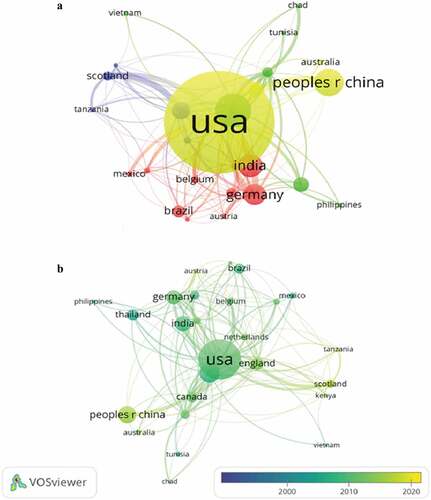
Co-occurrence of all keywords
A minimum number of co-occurrence of a keyword was selected at 3. Of the total 2,756 keywords, 539 meet the threshold. Rabies was the most used keyword (co-occurrence = 378, TLS = 2,530). TLS indicates the number of publications in which two keywords occur together. represents the co-occurrence of all keywords.
Figure 4. Minimum cluster size was fixed at 5, however six clusters are formed; red represents cluster 1 (n = 121 items), green represents cluster 2 (n = 109 items), blue represents cluster 3 (n = 95 items), yellow represents cluster 4 (n = 93 items), purple represent cluster 5 (n = 66 items), light–blue represents cluster 6 (n = 50 items), and orange represent cluster 7 (n = 5 items). (a) Network visualization of all keywords (wieghts: occurences). (b) Overlay visualization of all keywords by time 1991-2020 (wieghts: ocurrences, score: average publications per year)
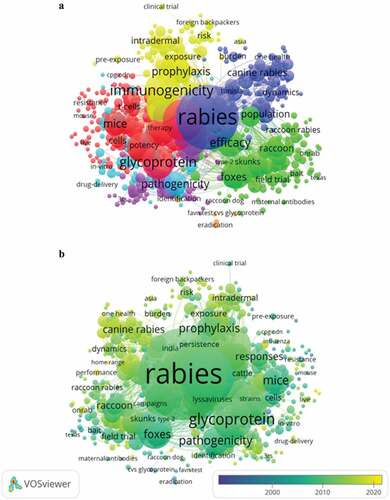
Authors citation
The minimum number of papers of an author, was fixed at 5, while minimum number of citations was 50. Of the 4,323 authors, 123 meet the threshold. Rupprecht, Charles E was the most prolific author (documents = 33, citations = 768, TLS = 826). Only 32 authors had published at least 10 studies. shows the authors' citation network visualization.
Figure 5. Minimum cluster size was 5. However, seven clusters are formed; red represents cluster 1 (n = 27 items), green represents cluster 2 (n = 22 items), blue represents cluster 3 (n = 17 items), yellow represents cluster 4 (n = 16) items, purple represent cluster 5 (n = 16 items), light-blue represents cluster 6 (n = 14 items), and orange represents cluster 7 (n = 11 items). (a) Network visualization of authors citation (wieghts: citations). (b) Overlay visualization by citations (wieghts: citations, scores: citations, minimum score = 50, maximum = 100)
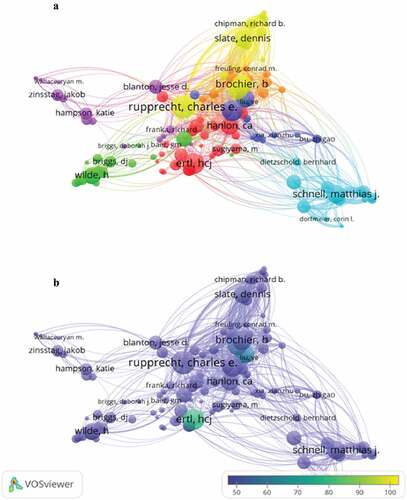
Discussion
Rabies is one of the most dangerous acute neurological diseases.Citation24 The most effective method to control rabies is PEP, that includes in-time vaccination with full doses. For several decades, intramuscular vaccination and WHO recommended a five-dose Essen regimen widely adopted globally. Essen regimen consists of five-doses of intramuscular injections: one dose of the vaccine in the deltoid region (or in children in the anterolateral thigh-muscle area) and should be given in 0, 3, 7, 14, and 28 days.Citation25 However, in low- and middle-income countries where this disease exists majorly – one of the significant challenges in vaccination is a withdrawal of exposed individuals in midway and fails to complete schedule vaccination thus, they remain at high risk of RABV infection.Citation25 This study is the first bibliometric analysis on rabies vaccine to highlights research and publication trends in the last three decades (1991-2020). It may be helpful for the academia, governmenent organizations, scholars, policymakers, and funders, to critically evaluate the funding applications and future research trends.
This bibliometric analysis found that among the published studies on rabies vaccine, 94.6% was research article and 5.8% was review article, showing that most of the published studies was based on experimental work rather than theoretical. While year-wise publication trend is not consistent and kept fluctuating in the last 3 decades with the highest number of publications was in 2019. It may be because of the sensitivity of the problem in the particular country or funding provision in the research area to enhance the research work leading to publications.Citation26
The USA was the most productive country followed by France and China in Rabies vaccine research and publication. This could be because research funding and the sensitivity of a country’s problem could improve the publishing process.Citation27 The funding sources clearly indicate that the top 3 funding agencies were from USA, collectively funded around 20% of the global funding in RVR and produced 36.4% of the publications. . This trend shows that sum of funding allocated for a disease is directly affecting the research and publications in a specific research area. Among the organizations focused on the rabies vaccine, CDC produced 7.68% of the total publications (1042) followed by Thomas and Jefferson University, which contributed 4.6% of the total, while Chulalongkorn University Thailand was the lowest with 1.92% of total publications. This may be due to the focus and priority of the organizations/institutes on specific research problems.Citation28
It is worth mentioning that the journal Vaccine that published the largest number of papers (218/1042) on rabies vaccine is placed in 1st position among the most attractive journals. Of the top-10 most cited studies, four were published in Vaccine. The year of publication also play a vital role in citations. The article published by Xiang in 1994 was the most cited article with 352 citations. Beside other factors, the nature of study also plays a significant role in getting more citations. The study published by Xiang on RABV in 1994 got total of 352 citations and only 3 citations in 2020. The co-authorship visualization network mapping showed that cooperation exists among most of the authors. The top-10 studies with the highest number of citations have multiple authors. However, the international collaboration among the groups/labs working on rabies vaccine is not as connected and robust as it should be.
Study limitations
This study has several limitations: (a) the data were retrieved from one database (b) only two search terms were used; and (c) the documents search was refined by year, document type, and language based on some studies were excluded from the final analysis. In addition, only studies on active vaccine were analyzed while studies on passive vaccine (i.e., RIG) were not included.
Conclusion
Of the total included literature, more than half (55%) of studies were produced in the USA, France, and People’s Republic of China. The most prolific author in RVR was Rupprecht CE, while the leading journal was Vaccine. Rabies was the most used keyword. This study might provide a reference to understand the current and future research trends in RVR. In developing countries, research collaboration and co-operation among institutes and researchers need to be strengthened with developed countries.
Highlights
To the best of our knowledge, this is the first bibliometric analysis on RVR to provide a comprehensive overview of global research in the last three decades (1991-2020).
This study may be constructive for clinicians, researchers, and for academia to provide useful bibliographic information and essential for future research trends.
The highest number of studies was produced in developed countries, i.e., the USA and France.
The most frequent year of publication in RVR was 2019.
Research collaboration between developing and developed countries need to be strenthenged.
Author’s contributions
TA: conceptualization, methodology, data collection, software, formal analysis, and writing-original draft preparation. TA, H, MK, MAM, MB, BNM, MMK, HH, and JH: review and editing. All the authors potentially contributed to this study, read, and agreed to the published manuscript.
Disclosure of potential conflicts of interest
The authors declare no potential conflict of interests.
Acknowledgments
The authors acknowledge Southeast University, Nanjing, China, for providing free online access to the WoSCC, SCI-E database.
Additional information
Funding
References
- Dietzgen RG, Kondo H, Goodin MM, Kurath G, Vasilakis N. The family Rhabdoviridae: mono- and bipartite negative-sense RNA viruses with diverse genome organization and common evolutionary origins. Virus Res. 2017;227:158–70. doi:10.1016/j.virusres.2016.10.010.
- World Health Organization (WHO). Rabies vaccines: WHO position paper–April 2018. Wkly Epidemiol Rec. 2018;93(16):201–19 [accessed 2021 Mar 7]. https://www.who.int/wer/2018/wer9316/en/.
- Moreira BLC, Gimenez APL, Inagaki JMF, Raboni SM. Inactivated rabies vaccines: standardization of an in vitro assay for residual viable virus detection. PLoS Negl Trop Dis. 2020;14(3):e0008142. doi:10.1371/journal.pntd.0008142.
- World Health Organization (WHO). Rabies. WHO; 2020 [accessed 2021 Mar 7]. https://www.who.int/en/news-room/fact-sheets/detail/rabies.
- Singh R, Singh KP, Cherian S, Saminathan M, Kapoor S, Manjunatha Reddy GB, Panda S, Dhama K. Rabies - epidemiology, pathogenesis, public health concerns and advances in diagnosis and control: a comprehensive review. Vet Q. 2017;37(1):212–51. doi:10.1080/01652176.2017.1343516.
- Hampson K, Coudeville L, Lembo T, Sambo M, Kieffer A, Attlan M, Barrat J, Blanton JD, Briggs DJ, Cleaveland S, et al. Global alliance for rabies control partners for rabies prevention. Estimating the global burden of endemic canine rabies. PLoS Negl Trop Dis. 2015;9(4):e0003709. Erratum in: PLoS Negl Trop Dis. 2015;9(5):e0003786. doi:10.1371/journal.pntd.0003709.
- World Health Organization. Rabies vaccines: WHO position paper, April 2018-Recommendations. Vaccine. 2018;36(37):5500–03. doi:10.1016/j.vaccine.2018.06.061.
- Moulenat T, Petit C, Bosch Castells V, Houillon G. Purified Vero cell Rabies Vaccine (PVRV, Verorab®): a systematic review of intradermal use between 1985 and 2019. Trop Med Infect Dis. 2020;5(1):40. doi:10.3390/tropicalmed5010040.
- World Health Organization (WHO). Information sheet observed rate of vaccine reactions rabies vaccine. WHO; 2012 [accessed 2021 Mar 7]. https://www.who.int/vaccine_safety/initiative/tools/Rabies_Vaccine_rates_information_sheet.pdf.
- Ahmad T, Musa TH, Jin H. Rabies in Asian countries: where we are stand. Biomed Res Ther. 2018;5(10):2719–20. doi:10.15419/bmrat.v5i10.485.
- Miranda MEG, Miranda NLJ. Rabies prevention in Asia: institutionalizing implementation capacities. Rabies and Rabies Vaccines. Springer, Cham. 2020. doi:10.1007/978-3-030-21084-7_6.
- WHO, World Organisation for Animal Health. Global elimination of rabies: the time is now [accessed 2021 Mar 7]. http://apps.who.int/iris/bitstream/10665/204621/1/WHO_HTM_NTD_NZD_2016.02_eng.pdf?ua=1.
- Arega S, Conan A, Sabeta CT, Crafford JE, Wentzel J, Reininghaus B, Biggs L, Leisewitz AL, Quan M, Toka F, et al. Rabies vaccination of 6-week-old puppies born to immunized mothers: a randomized controlled trial in a high-mortality population of owned, free-roaming dogs. Trop Med Infect Dis. 2020;5(1):45. doi:10.3390/tropicalmed5010045.
- Anderson A, Kotzé J, Shwiff SA, Hatch B, Slootmaker C, Conan A, Knobel D, Nel LH. A bioeconomic model for the optimization of local canine rabies control. PLoS Negl Trop Dis. 2019;13(5):e0007377. doi:10.1371/journal.pntd.0007377.
- Iftikhar PM, Ali F, Faisaluddin M, Khayyat A, De Gouvia De Sa M, Rao T. A bibliometric analysis of the top 30 most-cited articles in gestational diabetes mellitus literature (1946-2019). Cureus. 2019;11(2):e4131. doi:10.7759/cureus.4131.
- Moed HF. New developments in the use of citation analysis in research evaluation. Arch Immunol Ther Exp (Warsz). 2009;57(1):13–18. doi:10.1007/s00005-009-0001-5.
- Zhang Y, Quan L, Xiao B, Du L. The 100 top-cited studies on vaccine: a bibliometric analysis. Hum Vaccin Immunother. 2019;15(12):3024–31. doi:10.1080/21645515.2019.1614398.
- Mao X, Guo L, Fu P, Xiang C. The status and trends of coronavirus research: a global bibliometric and visualized analysis. Medicine (Baltimore). 2020;99(22):e20137. doi:10.1097/MD.0000000000020137.
- Mansoori P. 50 Years of Iranian clinical, biomedical, and public health research: a bibliometric analysis of the web of science core collection (1965-2014). J Glob Health. 2018;8(2):020701. doi:10.7189/jogh.08.020701.
- Li Y, Xu G, Long X, Ho YS. A bibliometric analysis of classic publications in web of science category of orthopedics. J Orthop Surg Res. 2019;14(1):227. doi:10.1186/s13018-019-1247-1.
- Ahmad T, Nasir S, Musa TH, AlRyalat SAS, Khan M, Hui J. Epidemiology, diagnosis, vaccines, and bibliometric analysis of the 100 top-cited studies on Hepatitis E virus. Hum Vaccin Immunother. 2021;17(3):857–871. doi:10.1080/21645515.2020.1795458.
- Ahmad T, Murad MA, Baig M, Hui J, Research trends in COVI-19 vaccie: a bibliometric analysis. Hum Vaccin Immunother. 2021;1–6. Epub ahead of print. doi:10.1080/21645515.2021.1886806.
- Van Eck NJ, Waltman L. Software survey: VOSviewer, a computer program for bibliometric mapping. Scientometrics. 2010;84(2):523–38. doi:10.1007/s11192-009-0146-3.
- Li T, Wang X, Cheng H. Meta-analysis of immunogenicity and safety of human rabies vaccination under Zagreb and Essen regimens. J Comp Eff Res. 2020;9(7):459–68. doi:10.2217/cer-2019-0202.
- Ashwath Narayana DH, Madhusudana SN, Sampath G, Tripathy RM, Sudarshan MK, Gangaboraiah G, Ravish HS, Satapathy DM, Gowda G, Holla R, et al. Safety and immunogenicity study of a new purified chick embryo cell rabies vaccine Vaxirab-N (Pitman-Moore strain) manufactured in India. Hum Vaccin Immunother. 2014;10(1):120–25. doi:10.4161/hv.26456.
- Jiang Y, Hu R, Zhu G. Top 100 cited articles on infection in orthopaedics: a bibliometric analysis. Medicine (Baltimore). 2019;98(2):e14067. doi:10.1097/MD.0000000000014067.
- Kim ES, Yoon DY, Kim HJ, Lee K, Kim Y, Bae JS, Lee JH. The most mentioned neuroimaging articles in online media: a bibliometric analysis of the top 100 articles with the highest altmetric attention scores. Acta Radiol. 2019;60(12):1680–86. doi:10.1177/0284185119843226.
- Merigó JM, Blanco-Mesa F, Gil-Lafuente AM, Yager RR. Thirty years of the international journal of intelligent systems: a bibliometric review. Int J Intell Syst. 2017;32:526–54. doi:10.1002/int.21859.

